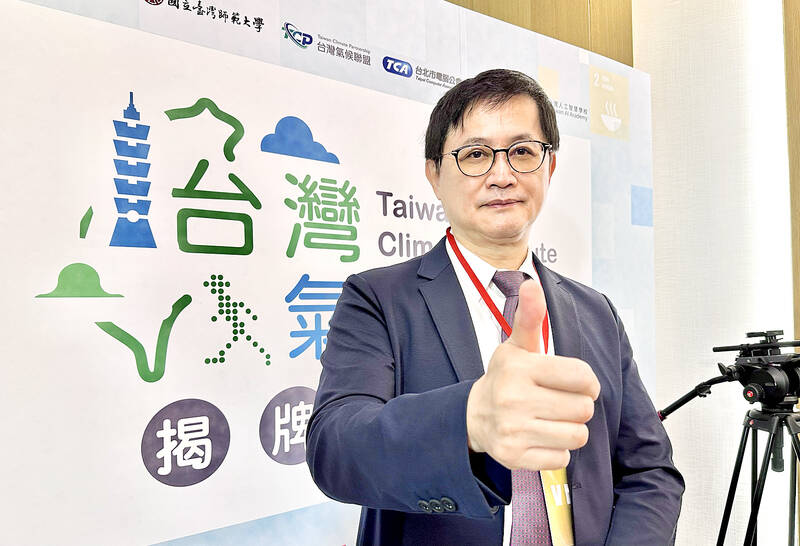A wave of supply chain relocation away from China is partly driven by the desire of companies to diversify their geopolitical risks, Tung Tzu-hsien (童子賢), chairman of Taiwan-based contract electronics maker Pegatron Corp (和碩), said on Wednesday.
Speaking at the Taiwan Women on Boards Association’s annual convention on the impact of geopolitics on Taiwanese businesses’ investment strategies, Tung said that geopolitical factors have to be accounted for when companies consider where to manufacture products.
“In 2000, businesses did not have to worry about international politics. As long as you provided good services and were capable of good marketing, you could sell your products globally,” he said.

Photo: Fang Wei-chieh, Taipei Times
“But now you have to take note of geopolitical changes, such as wars and trade friction, to keep your products from being banned or sanctioned,” he said.
That shift can be seen in how the workforce of Pegatron, which as a contract manufacturer deploys most of its capacity overseas — usually in economies with relatively low labor costs — has changed in recent years.
The company’s Chinese factories used to employ about 200,000 workers during peak seasons, Tung said, but in the past three years, Pegatron’s factories in Mexico, India, Vietnam and Indonesia have had a combined workforce of about 30,000.
Beyond political factors, Tung said today’s relocation wave to countries such as India and Vietnam mirrors the massive migration of Taiwanese manufacturers to China in the 1990s, and that “history is repeating itself.”
“China’s GDP per capita has reached about US$13,000, which was the level when Taiwanese factories started to relocate to China and away from Taiwan years ago,” he said.
Even Chinese companies are complaining about the high cost of labor in Shanghai and Suzhou and are moving to Southeast Asia, Tung said.
“Taiwanese businesses started to move to China around 1995,” and because supply chains were still not mature in China they had to rely on sources of supply in Taiwan, Tung said.
“But a few years later in 2000, China’s local supply chains began to take shape, with costs about one-fifth of those in Taiwan,” Tung said.
By 2003, “Asustek Computer Inc (華碩) could not find supply chains in Taiwan as all the mold makers, and component and PCB [printed circuit board] factories had moved to China’s coastal regions such as Guangdong, Shanghai and Suzhou,” Tung said.
This is what is happening now, Tung said, adding that supply chain clusters are taking shape in countries in the Global South such as India, Mexico, Indonesia and Thailand.

The New Taiwan dollar is on the verge of overtaking the yuan as Asia’s best carry-trade target given its lower risk of interest-rate and currency volatility. A strategy of borrowing the New Taiwan dollar to invest in higher-yielding alternatives has generated the second-highest return over the past month among Asian currencies behind the yuan, based on the Sharpe ratio that measures risk-adjusted relative returns. The New Taiwan dollar may soon replace its Chinese peer as the region’s favored carry trade tool, analysts say, citing Beijing’s efforts to support the yuan that can create wild swings in borrowing costs. In contrast,

Nvidia Corp’s demand for advanced packaging from Taiwan Semiconductor Manufacturing Co (TSMC, 台積電) remains strong though the kind of technology it needs is changing, Nvidia CEO Jensen Huang (黃仁勳) said yesterday, after he was asked whether the company was cutting orders. Nvidia’s most advanced artificial intelligence (AI) chip, Blackwell, consists of multiple chips glued together using a complex chip-on-wafer-on-substrate (CoWoS) advanced packaging technology offered by TSMC, Nvidia’s main contract chipmaker. “As we move into Blackwell, we will use largely CoWoS-L. Of course, we’re still manufacturing Hopper, and Hopper will use CowoS-S. We will also transition the CoWoS-S capacity to CoWos-L,” Huang said

Nvidia Corp CEO Jensen Huang (黃仁勳) is expected to miss the inauguration of US president-elect Donald Trump on Monday, bucking a trend among high-profile US technology leaders. Huang is visiting East Asia this week, as he typically does around the time of the Lunar New Year, a person familiar with the situation said. He has never previously attended a US presidential inauguration, said the person, who asked not to be identified, because the plans have not been announced. That makes Nvidia an exception among the most valuable technology companies, most of which are sending cofounders or CEOs to the event. That includes

INDUSTRY LEADER: TSMC aims to continue outperforming the industry’s growth and makes 2025 another strong growth year, chairman and CEO C.C. Wei says Taiwan Semiconductor Manufacturing Co (TSMC, 台積電), a major chip supplier to Nvidia Corp and Apple Inc, yesterday said it aims to grow revenue by about 25 percent this year, driven by robust demand for artificial intelligence (AI) chips. That means TSMC would continue to outpace the foundry industry’s 10 percent annual growth this year based on the chipmaker’s estimate. The chipmaker expects revenue from AI-related chips to double this year, extending a three-fold increase last year. The growth would quicken over the next five years at a compound annual growth rate of 45 percent, fueled by strong demand for the high-performance computing